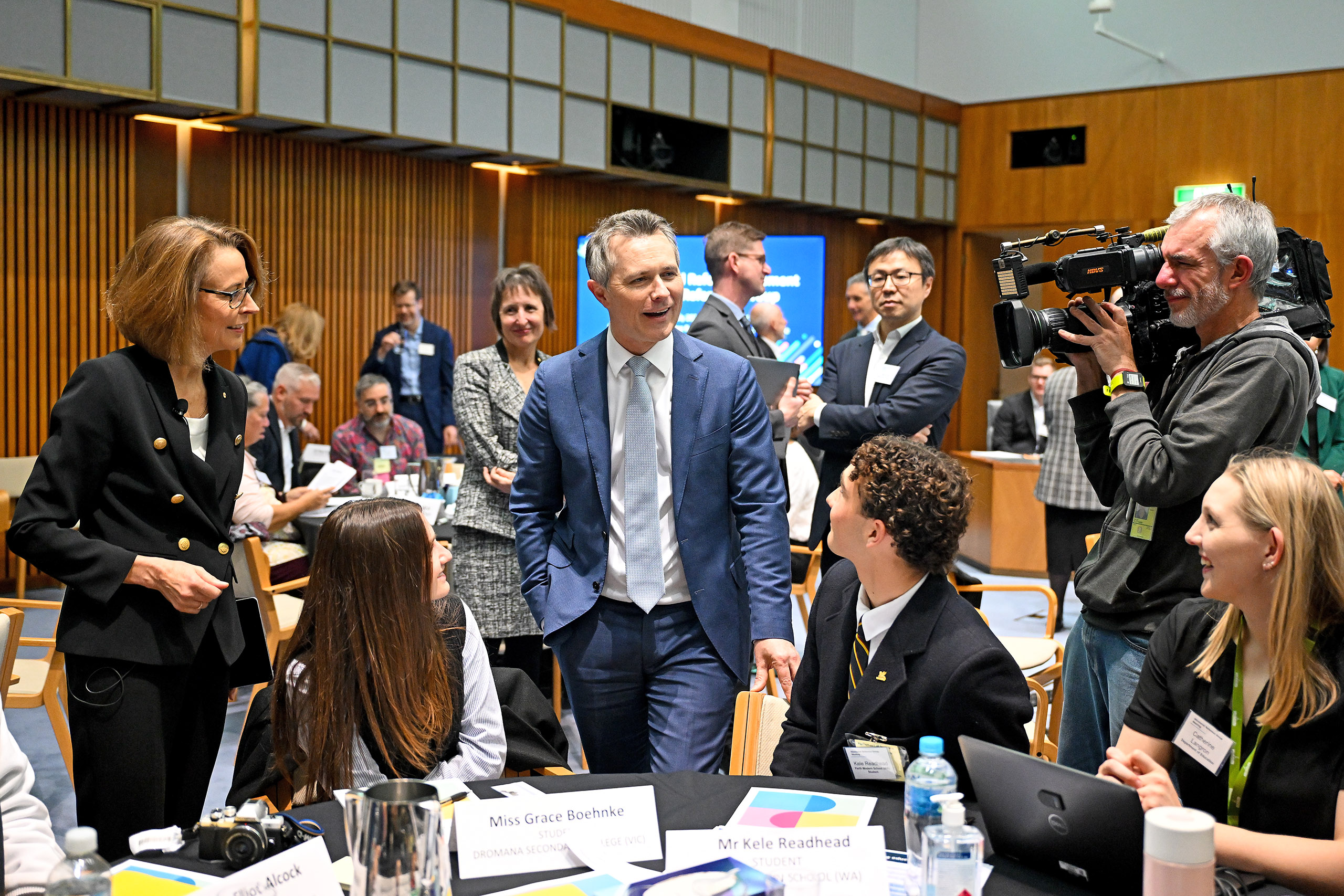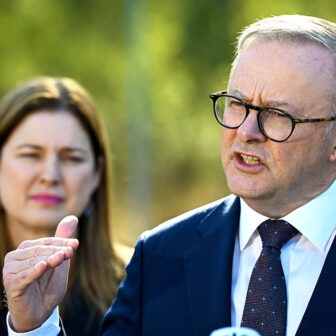There are many reasons why the parents of some Australian MPs chose to have their children educated in government schools while the parents of others opted for Catholic or independent schools. Speculating or judging doesn’t get us very far when we’re trying to understand the present-day failings of the school system. But could the recent experiences of the schools attended by those MPs give an insight into the inequalities that the Gonski report tried to fix? And might they also guide the MPs when they vote on a new federal–state reform agreement this year?
This analysis uses detailed information about the schools listed by half of all federal MPs in their parliamentary profiles. Using the Index of Community School Socio-educational Advantage, or ICSEA, these schools can be divided into three broad groups: the least-advantaged, which include those with an ICSEA value up to 999; the middle schools, which fall between 1000 and 1099; and the wealthiest, with an ICSEA above 1100. (The ICSEA is calculated using background data on parents’ occupation and education.)
As the chart shows (click to enlarge), twenty-six of the MPs once attended the lowest-ICSEA schools, all of which are public schools; nineteen of them are Labor members. Forty-two of the MPs attended middle-ICSEA schools, which are a more diverse group — predominantly Catholic, with some government schools and just a few independent schools. Party affiliations are spread across this middle group.
The highest-ICSEA schools, which were attended by fifty of the MPs, are dominated by thirty independent schools and some high-fee Catholic schools. Most of these MPs are in the Coalition parties, a dozen are Labor members, and five are teal independents.
The way they were
This analysis focuses on the past twelve years — the years since the Gonski report was released in 2011 and the years for which detailed information is available. It tells a clear then-and-now story.
What did these schools look like in 2011?
• The lowest-ICSEA schools had the most disadvantaged intake, with an average of 44 per cent of their students falling into the most-disadvantaged quarter in 2011; Simon Birmingham’s and Pat Conroy’s schools were among them. In the middle-ICSEA schools, by contrast, just 17 per cent of students were in the lowest ICSEA quarter. Those schools included Stephen Jones’s and Jim Chalmers’s. In even more of a contrast, just 3 per cent of students in the highest-ICSEA schools were drawn from the most-disadvantaged quarter, including in Amanda Rishworth and Mark Burnley’s public school.
• The distribution of students in the most advantaged quarter was the reverse: 8.5 per cent in the lowest-ICSEA group of schools (including Chris Bowen’s and Jacqui Lambie’s schools), 27 per cent in the middle group (including Catherine King’s and Don Farrell’s schools) and 65 per cent in the highest group (including Angus Taylor’s and Richard Marles’s schools).
• Indigenous students made up 7 per cent of enrolments in the lowest-ICSEA schools (which include Bert Van Manen’s and Kristy McBain’s schools), 2 per cent in the middle group (Sharon Claydon’s school), and less than 1 per cent in the highest-ICSEA schools.
• In public funding, the lowest-ICSEA group averaged $13,000 per student, the middle group $10,200, and the upper group $6000. In overall terms, more (but not much more) public funding went to the most needy students.
• In total funding, though, the lowest-ICSEA group averaged $13,600 per student, the middle group $13,000 and the upper group $19,200. Governments’ efforts to favour the neediest students were (and still are) reversed by schools’ income from fees.
• School-by-school funding figures in 2011 reveal hard-to-explain differences between otherwise similar schools. In the lowest-ICSEA group the per-student funding of Anne Stanley’s Lurnea High School was 44 per cent higher than Jason Clare’s old school, Canley Vale High School. In the middle group, Michael McCormack’s Trinity College in Wagga was funded well ahead of Helen Haines’s Trinity College in Colac.
• And there was also a hierarchy of schools according to their size, ranging from a low of 798 students on average in the lowest-ICSEA schools, to 991 in the middle and 1269 in the highest-ICSEA group.
From then to now
These differences between schools in 2011 were certainly noticed by the Gonski review, and a stronger emphasis on needs-based funding was part of Gonski’s solution. The review also found that the growing concentration of disadvantaged children in certain schools was damaging overall results. Why? Because student peers are an even greater influence on students’ performance than a student’s background.
But Gonski’s equity funding solution became a victim of political timidity, compromises and bastardry at a number of levels, and was never in itself going to deal with the cause of the problem, namely the segregation of student enrolments.
So what has happened to the politicians’ schools over the last dozen years?
The least advantaged schools: This lowest-ICSEA group includes the schools once attended by Labor MPs Jason Clare, Chris Bowen, Pat Conroy, Ed Husic and Madeline King, along with non-Labor politicians Bert Van Manen, Kylea Tink, Tammy Tyrell, Simon Birmingham and Jacqui Lambie.
If their schools were disadvantaged in 2011 they are even more so now. On average across Australia 25 per cent of enrolled students fall into the least-advantaged SES quarter, but they have risen from 43 per cent to 51 per cent of all enrolled students in this group of schools — especially in the schools once attended by Van Manen, Husic, King, Birmingham and Louise Miller-Frost. Most of these schools also lost a portion of their most advantaged students in a shift that was especially noticeable in the schools attended by Fiona Phillips, Anthony Chisholm and Jenny McAlister.
Notwithstanding the diversity of Indigenous Australia, the lower-ICSEA schools now enrol a greater proportion of Indigenous students, markedly so in the former schools of Julie Collins, Van Manen, Kristy McBain, Fiona Phillips, Tammy Tyrell, Anne Ruston and Tim Ayres.
Have all these changes affected the achievement profile of the schools? This is best seen in the diminishing number of high-achievers in the low-ICSEA schools. Using the representation of Year 12 distinguished achievers in New South Wales as a measure, only two schools in this group recorded an increase. The federal education minister’s former school has been enrolling more high scorers, but the declines elsewhere are very real.
What about school funding? It would be reasonable to assume that these schools’ funding has reflected their growing disadvantage. Combined government funding since 2011 has increased by an average of 47 per cent across this group of schools, but that’s scarcely more than the 44 per cent for the more advantaged middle-ICSEA group. (All figures in this analysis are nominal dollar figures; the inflation rate over this period was roughly 35 per cent.) The money certainly hasn’t followed the need to the extent anticipated.
Many dollar oddities emerge when schools are compared. Madeline King might wonder why the public funding of her WA school has risen by just 19 per cent in a decade while the similar NSW school of her caucus colleague Jenny McAlister has received a 52 per cent increase. Keith Pitt’s Queensland school has received 39 per cent more than in 2011 but public funding of Anne Ruston’s SA school rose by 61 per cent. When it comes to the resourcing of their schools, young people are in a state-of-origin lottery.
The middle group of schools: The predominantly Catholic schools in the middle-ICSEA group have fared much better. On average, the portion of their students who are in the lowest and highest ICSEA groups has remained little changed. Almost all the schools have grown in size — and, again on average, both their public and total per-student funding has increased almost as much as for the schools in the first group.
A closer look reveals complexity and contradictions within this group. The ICSEA status of three schools, one from each sector, has considerably declined for reasons not readily apparent: Fatima Payman’s former school now has many more disadvantaged and fewer advantaged students, Ian Goodenough’s and Lidia Thorpe’s schools even more so.
Eight schools display the reverse: having shed the disadvantaged, accumulating more advantaged students and, in the process, growing in size. These include the former schools of Patrick Gorman, Andrew Wilkie, Tanya Plibersek, Jim Chalmers, Andrew Wallace, Stephen Jones, Deborah O’Neill and Raff Ciccone. Most of these schools reaped the benefits of a higher academic profile.
This second group of schools also illustrates how public funding per student can vary considerably between otherwise similar schools in ways that might raise a few eyebrows among federal politicians. The size and make-up of schools, and where they are located, will always be factors. But the oddities include:
• Each student at Jonathan Duniam’s Tasmanian school is funded at $19,265 against $15,117 for each at Zaneta Mascarenhas’s more remote John Paul College in Kalgoorlie
• Each student at Michael McCormack’s former Catholic school in Wagga is funded $3500 more than each student at the Islamic College in Dianella.
• Students at Susan Templeman’s Strathfield GHS appear to be valued at $4000 less than those at De La Salle Cronulla (Tony Sheldon)… and those at Katy Gallagher’s old school (Canberra College, ICSEA 1091) receive more funding than those at Jason Clare’s old school (Canley Vale High School, ICSEA 932).
• Students at Anthony Albanese’s St Mary’s Cathedral College (ICSEA 1097) are publicly funded at the same level as those at Sally Sitou’s Sefton High School (ICSEA 1005).
Those on top, stay on top
In statistical terms, the highest-ICSEA group increasingly seems to exist in a parallel universe, measurably separate from the other two groups. Their portion of students in both the lowest and highest ICSEA quarters is largely unchanged. And — despite occasional public relations claims to the contrary — in all but four schools they enrol a similar percentage of Indigenous students as they did in 2011.
What about funding? Despite enrolling more advantaged students, the average 40 per cent increase in public funding per student receive by the highest-ICSEA schools isn’t much less than the middle group (44 per cent) and the lowest (47 per cent) — and that’s before income from other sources is added. On top that, there seems to be an odd relationship between public and total funding:
• Xavier College, once attended by Bill Shorten and Dan Teehan, received more public funding over the twelve years but the public funding of Monique Ryan and Clare O’Neill’s school (Loreto Mandeville Hall) barely shifted.
• Amanda Rishworth and Mark Burnley’s Unley High School (also once attended by Julia Gillard) received 41 per cent more public funding over the twelve years but the much higher-ICSEA Geelong Grammar, once attended by Richard Marles, received 73 per cent more.
• The Scots College (Andrew Hastie) in Sydney appropriately received only 29 per cent in extra public funding, but its total funding has almost doubled since 2011.
Student achievement? The proportion of HSC distinguished achievers grew in all the twenty-one NSW schools in the highest-ICSEA group. The most spectacular rise was at Knox Grammar (Andrew Charlton), explained at least partly by the school’s 50 per cent enrolment growth. Two-thirds of these schools also increased their enrolment over this period, and usually held or increased their share of the most advantaged students.
Compound the problems, or search for solutions?
The revelation that Australia is dividing up its young people into separate schooling pathways on the basis of family advantage isn’t new. It has accelerated since the 1980s and is clearest in the lowest-ICSEA schools, where the most disadvantaged now form half of enrolments. These are the schools that families with any choice scramble to avoid. The resulting segregation, combined with regressive and divisive peer effects on learning, weighs against overall system capacity and improvement.
While some families can distance themselves from the strugglers, the nation has no such option. Federal MPs would be well-advised to reflect on their own school experience in its wider and current context. In the process they could push for three essential changes if Australian school education is to achieve the holy grail of equity and excellence: full equity funding, evidence-based school reform, and the wider structural changes needed to ensure that the first two deliver on their promise.
Dealing with these three priorities requires thinking outside the square. Full funding isn’t just about money, it is also about reforming Australia’s federal–state responsibilities so that they deliver a sustainable fix. School reform won’t deliver if it focuses only on classrooms and fails to take a closer look at how schools can engage all young people in learning. This urgent need is best encapsulated in Dean Ashenden’s recent book, Unbeaching the Whale: Can Australia’s Schooling Be Reformed? And for an illustration of how authentic reforms can work, MPs could do worse than visit schools that are doing it right now.
We need all three — equitable funding, evidence-based reform and structural change — at the same time. Full equity funding won’t deliver if the extra investment doesn’t create wide-reaching reform. And the story of the politicians’ schools suggests that equity funding, school reform and overall student outcomes will always fall short if we continue to put the disadvantaged literally in a class of their own. Can anyone be surprised that other countries have avoided ending up where we are, or are looking for a way out? It is surely time to contemplate alternatives.
Somewhat perversely, the good news is that Australia’s current problems have surely become too big to ignore. In the words of the recent federal review, “the current system entrenches educational disadvantage and makes it less likely that other reforms will realise Australia’s longstanding ambition of equity and excellence.” In saying this, it built on concerns raised by the Productivity Commission.
The impending national schools agreement could be the last chance to get it right. Half a century ago, and regardless of their intention, governments created what we have today: a system driven by the self-interest of the most powerful that delivers an ever-sharpening hierarchy of schools that seems to endlessly fall short of expectations. It is a win–lose system that creates advantages for the best-resourced families at the expense of others. Efforts to change this have always fallen short, hence the divides continue to play out, from the smallest communities into the corridors of power, including in federal parliament.
That could change if Australia’s federal politicians are driven not only by their own school experiences but by an understanding of what went wrong and a commitment to make it right. •




